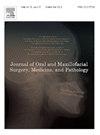一例口腔炎后的药物过敏综合征(DIHS)/嗜酸性粒细胞增多和全身症状的药物反应(DRESS)病例
IF 0.4
Q4 DENTISTRY, ORAL SURGERY & MEDICINE
Journal of Oral and Maxillofacial Surgery Medicine and Pathology
Pub Date : 2024-07-17
DOI:10.1016/j.ajoms.2024.07.007
引用次数: 0
摘要
药物致过敏综合征/药物反应伴嗜酸性粒细胞增多和全身症状(DIHS/DRESS)是一种具有明显特征的药物相关性皮疹的严重形式。这种疾病的特点是特异性致病性药物的晚发性,尽管停用致病性药物,症状仍会恶化,随后出现器官功能障碍。值得注意的是,DIHS/DRESS是由人疱疹病毒6 (HHV-6)的再激活引起的。本文报告1例DIHS/DRESS患者因口腔炎住院期间出现皮疹、发热和肝功能障碍,并确认HHV-6再激活。一位67岁男性患者因口腔黏膜疼痛,一直服用卡马西平治疗脑出血后遗症,被转介至我院。最初,他被诊断为疱疹病毒感染,并接受了阿昔洛韦治疗。之后,尽管口腔炎有所改善,但躯干出现丘疹并恶化。伴有发热和肝功能障碍。最终,患者出现收缩压下降、呼吸急促和心房颤动。经类固醇脉冲治疗后,患者临床情况好转。用DIHS/DRESS进行实时聚合酶链反应,检测HHV-6 DNA。基于这一过程,我们诊断患者为卡马西平所致DIHS/DRESS。本文章由计算机程序翻译,如有差异,请以英文原文为准。
A case of drug-induced hypersensitivity syndrome (DIHS)/drug reaction with eosinophilia and systemic symptoms (DRESS) following stomatitis
Drug-induced hypersensitivity syndrome/drug reaction with eosinophilia and systemic symptoms (DIHS/DRESS) is a severe form of drug-related rash with distinct features. This condition is characterized by late onset from specific causative drugs, and symptoms worsen despite discontinuation of the causative agent, followed by organ dysfunction. Notably, DIHS/DRESS results from the reactivation of human herpesvirus 6 (HHV-6). Herein, we report a case of DIHS/DRESS in which rash, fever and liver dysfunction were observed during hospitalization for stomatitis, and HHV-6 reactivation was confirmed. A 67-year-old man who had been taking carbamazepine for the sequelae of cerebral hemorrhage was referred to our hospital because of pain in the oral mucosa. Initially, he was diagnosed with a herpes virus infection and treated with acyclovir. Afterward, despite improvement in stomatitis, papules appeared on the trunk of the body and worsened. The symptoms were accompanied by fever and liver dysfunction. Eventually, the patient developed decreased systolic blood pressure, tachypnea, and atrial fibrillation. After pulse steroid therapy was initiated, the patient’s clinical condition improved. Real-time polymerase chain reaction was performed suspecting with DIHS/DRESS, and HHV-6 DNA was detected. Based on this process, we diagnosed the patient with DIHS/DRESS induced by carbamazepine.
求助全文
通过发布文献求助,成功后即可免费获取论文全文。
去求助
来源期刊

Journal of Oral and Maxillofacial Surgery Medicine and Pathology
DENTISTRY, ORAL SURGERY & MEDICINE-
CiteScore
0.80
自引率
0.00%
发文量
129
审稿时长
83 days
 求助内容:
求助内容: 应助结果提醒方式:
应助结果提醒方式:


